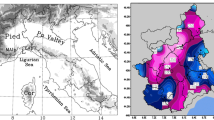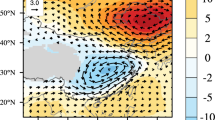Abstract
RIEMS’ ability to simulate extreme monsoon rainfall is examined using the 18-month (April 1997 September 1998) integrated results. Model-simulated heavy precipitation over the Yangtze River valley during 11–30 June 1998 is compared with the observation, and the relationships between this heavy rainfall process and the large-scale circulations, such as the westerly jet, low-level jet, and water vapor transport, are analyzed to further understand the mechanisms for simulating heavy monsoon rainfall. The analysis results show that (1) RIEMS can reproduce the pattern of heavy precipitation over the Yangtze River valley during 11–30 June 1998, but it is shifted northwestwards. (2) The simulated West Pacific Subtropical High (WPSH) that controls the East Asia Monsoon evolution is stronger than the observation and is extended westwards, which possibly leads to the north westward shift of the heavy rain belt. (3) The Westerly jet at 200 hPa and the Low-level jet at 850 hPa, both of which are related to the heavy monsoon rainfall, are reasonably reproduced by RIEMS during 11–30 June 1998, although the intensities of the simulated Westerly/Low-level jets are strong and the location of the Westerly jet leans to the southeast, which may be the causes of RIEMS producing too much heavy rainfall in the north of the Yangtze River valley.
Similar content being viewed by others
References
Dickinson, R. E., P. J. Kennedy, A. Henderson-Sellers, and M. Wilson, 1986: Biosphere-Atmosphere Transfer Scheme (BATS) for the NCAR Community Climate Model. Tech. Note, NCAR/TN-275+STR, National Center for Atmospheric Research, Boulder, CO, 69pp.
Ding Yihui, 1991:Advanced Synoptic Meteorology, China Meteorological Press, 792pp.
Fu Congbin, Wei Helin, Chen Ming, Su Bing Kai, Zhao Ming, and Zheng Weizhong, 1998: Simulation of the evolution of summer monsoon rainbelts over eastern China from regional climate model.Chinese Jounal of Atmospheric Sciences,22(4), 522–534.
Fu Congbin, Wei Helin, and Qian Yun., 2000: Documentation on Regional Integrated Environmental Model System (RIEMS, Version I). TEACOM Science Report, No, 1, START Regional Committee for Temperate East Asia, Beijing, China, 36pp.
Gates, W. L., 1992: The atmospheric model intercomparison Project.Bull. Amer. Meteor. Soc.,73, 1962–1970.
Gong Wei, Li Weiliang, and Zhou Xiuji, 1996: Modeling summer precipitation in China by a modified NCAR RegCM.Studies on Short-term Climate Variations and Their Formation in China, Cao Hongxing, Li Yuehong, Wei Fengying, Eds., China Meteorological Press, Beijing, 110–116. (in Chinese)
Groth, S. L., and M. C. MacCracken, 1991: The use of general circulation models to predict regional climate change.J. Climate,4, 286–303.
Holtslag, A. A. M., E. I. F. de Bruijin, and H. L. Pan, 1990: A high resolution air mass transformation model for short range weather forecasting.Mon. Wea. Rev.,118, 1561–1575.
Liu Yongqiang, R. Avissar, and F. Giorgi, 1996: A simulation with the regional climate model RegCM2 of extremely anomalous precipitation during the 1991 East-Asian flood: An evaluation study.J. Geophys. Res.,101, 26199–26215.
Luo Yong, and Zhao Zongci, 1997: Numerical simulation of East Asia regional climate with NCAR RegCM2.Quarterly Journal of Applied Meteorology, 8(Suppl.), 124–133. (in Chinese)
National Climate Center, 1998:China Climate Impact Assessment, China Meteorological Press, 34pp.
Palmen, E., and C. W. Newton, 1969:Atmospheric Circulation Systems. International Geophysics Series, Vol. 13, Academic Press, New York and London,13, 471–560.
Wei Helin, Fu Congbin, and W. C. Wang, 1998: The effect of lateral boundary treatment of regional climate model on the East Asian summer monsoon rainfall simulation.Chinese Journal of Atmospheric Sciences,22(3), 231–243.
Wei Helin, and W. C. Wang, 1998: A regional climate model simulation of summer monsoon over East Asia: A case study of 1991 flood in Yangtze-Huaihe valley.Advances in Atmospheric Sciences,15(4), 489–509.
Xu Xiangde, Miao Qiuju, Wang Jizhi, and Zhang Xuejin, 2003: The water vapor transport model at the regional boundary during the Meiyu Period.Advances in Atmospheric Sciences,20(3), 333–342.
Zhai Guoqing, Ding Huajun, Sun Shuqing, 1999: Physical Characteristics of Heavy Rainfall Associated with Strong Low-level Jet.Chienese Journal of Atmospheric Sciences,23(1), 112–118.
Author information
Authors and Affiliations
Corresponding author
Rights and permissions
About this article
Cite this article
Zhe, X., Shuyu, W., Zhaomei, Z. et al. Analysis of simulated heavy rain over the Yangtze River valley during 11–30 June 1998 using RIEMS. Adv. Atmos. Sci. 20, 815–824 (2003). https://doi.org/10.1007/BF02915407
Received:
Revised:
Issue Date:
DOI: https://doi.org/10.1007/BF02915407




